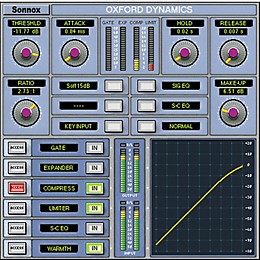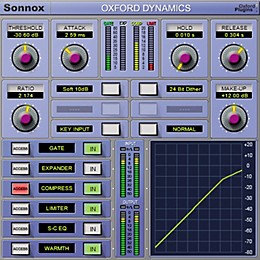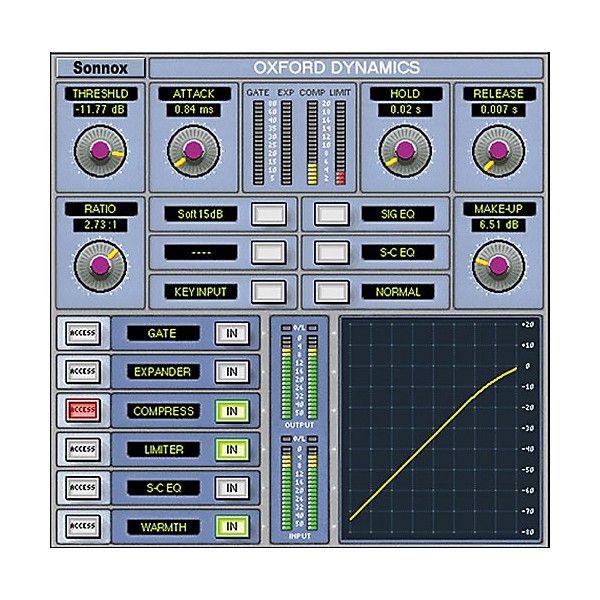Gear SpecialistBundlingMusician
Get exclusive savings on top brands like Yamaha, Akai and Oberheim when you call 866-498-7882 or chat
Download
Sonnox Oxford Dynamics (Native) Software Download
(0)|Q&A|Item #:1308847078045 POS #:107229023
$271.00
6-month special financing^ + $13 back in Rewards** Limited time Learn More
Save on orders $199+ and get expert advice from a Gear Adviser
Need Help?
Videos (1)
View All

SONNOX VSSD OXFORD DYNAMICS HD-HDX

 Description
Description
The Sonnox Oxford Dynamics plug-in for Native systems is modeled on the extremely flexible and capable unit used in the Sony OXF-R3 professional mixing console. Resulting from many years research into professional dynamics applications, it offers separate Compress, Limit, Expand, Gate and side chain EQ functions, with full independent control of all parameters. Features such as selectable time constant curves and variable soft compress functions allow the user to confidently tackle all common uses of compression, from subtle unobtrusive level control and mastering functions to the production of great artistic effects. The use of a feed-forward architecture with logarithmic side chain processing, making use of look-ahead techniques, ensures exemplary sonic characteristics and dynamic accuracy, with an artistic capability simply unavailable from other single units, analogue or digital. This highly sophisticated and professional product has the power and flexibility to obviate the need for many of the separate applications most users keep for specific uses.
General
The Oxford Dynamics plug-in is a highly sophisticated device with comprehensive control of many parameters. Therefore, to aid operation, there is separate page of controls for each process, since it would not be feasible to have all controls and displays available on a single page.
Although there are four gain level controlling processes, Gate, Expander, Compressor and Limiter in the mono and stereo plug-ins, their control signals are all derived from a single side-chain detector, operating on a single gain control element. The amount of processing necessary to allow a detector for each process would be far too great for current processor capabilities, if done correctly.
Feed-Forward Architecture
The type of architecture in the Oxford Dynamics uses feed-forward techniques. In this case, a tiny delay is introduced into the signal path. (The amount of delay is virtually insignificant, and can be compensated for, in order that all signal paths are aligned, in any case.) This delay allows time for the side-chain control signal to be generated so that it can coincide exactly with the signal it will control. This technique allows very accurate control of the audio levels by generating totally precise control signals, thus preserving audio quality.
Gate
The gate acts like a switch, where signals below the THRESHOLD setting are attenuated, according the the RANGE control setting. This type of function is useful for suppressing unwanted background noises, such as tape hiss, where the wanted signal is well defined. Gates are very useful on drums and percussive instruments too.
Once the signal reaches levels above the THRESHOLD, the gate opens allowing the signal through at full level. When the signal level falls, it must reduce to 4dB below the THRESHOLD before the gate will close again. This is known as 4dB of hysteresis. Increasing the ATTACK time, softens the attack 'edge', and the RELEASE sets the time for the closure take to take place. The HOLD sets the minimum time before the gate is able to close again.
Expander
The expander has all the same controls as the gate with the addition of a RATIO control. But whereas the gate acts like a switch, allowing the full signal through once the THRESHOLD has been reached, the expander allows the signal level to increase, according to the slope of RATIO setting. This function can be used to lower background background noises but is particularly useful for increasing the dynamic attack of any musical instruments which are percussive nature, such as drums, percussion and acoustic guitar.
Compressor
The compressor allows gain reduction to signals beyond the level set by the THRESHOLD according to the RATIO setting. The RATIO can be set anywhere between 1:1, where no compression takes place, and 1000:1 where virtually total limiting takes place, meaning that there is no increase in level whatsoever for signal level beyond the THRESHOLD.
The ATTACK determines how quickly the compression sets in, allowing initial transients to pass, with the longer settings, useful to pass the intial attach of percussive intruments. The RELEASE sets the time taken to recover to no gain reduction, once the signal has returned to a level below the THRESHOLD. The start of the RELEASE phase can be further delayed by increasing the HOLD control.
The transfer curve of the compressor will normally show a corner at the THRESHOLD point, the transition between no gain reduction and gain reduction. This corner can be 'smoothed' using the SOFT function which helps to 'hide' compression.
When compression takes place, the overall signal is reduced at the higher levels, normally requiring the level to be 'made up' again. The MAKE-UP gain control allows for this.
Limiter
The limiter is designed to set a fixed ceiling for signals according to the THRESHOLD setting. Although it does have an ATTACK control which can allow initial transients to pass, at the medium and fastest ATTACK setting, the signal can be retained so as not to exceed the THRESHOLD. This is achieved with 'feed forward - look ahead' techniques and allows initial attack transients to be significantly modified without breaching the THRESHOLD setting.
Limiters were originally designed to prevent transmission systems being overloaded but are often used as artistic tools too. The ATTACK, HOLD and RELEASE behave in a similar manner to those of the compressor, but have different ranges.
Side-Chain EQ
The side-chain equalizer is a fully parametric 2 band section. Its main purpose is to allow modification of the frequency response of the side-chain signal path for functions such as 'de-essing'. It is possible to use it in the main signal path alone as an additional 2 band equalizer, or it can be used in the side-chain alone, or for both the signal path and side-chain combined.
Warmth
The AMOUNT control allows the addition of harmonically related signal with a tube or electronic valve like characteristics. Signal increases of up to 6dB can be achieved within the audio, but without going over the digital maximum. MAX TRIM allows fine tuning in order to compensate the peak level. The warmth function is indepedent without dependency on other dynamic processes.
NOTE: Sonnox plug-ins require a 2nd Generation iLok for authorization.
General
The Oxford Dynamics plug-in is a highly sophisticated device with comprehensive control of many parameters. Therefore, to aid operation, there is separate page of controls for each process, since it would not be feasible to have all controls and displays available on a single page.
Although there are four gain level controlling processes, Gate, Expander, Compressor and Limiter in the mono and stereo plug-ins, their control signals are all derived from a single side-chain detector, operating on a single gain control element. The amount of processing necessary to allow a detector for each process would be far too great for current processor capabilities, if done correctly.
Feed-Forward Architecture
The type of architecture in the Oxford Dynamics uses feed-forward techniques. In this case, a tiny delay is introduced into the signal path. (The amount of delay is virtually insignificant, and can be compensated for, in order that all signal paths are aligned, in any case.) This delay allows time for the side-chain control signal to be generated so that it can coincide exactly with the signal it will control. This technique allows very accurate control of the audio levels by generating totally precise control signals, thus preserving audio quality.
Gate
The gate acts like a switch, where signals below the THRESHOLD setting are attenuated, according the the RANGE control setting. This type of function is useful for suppressing unwanted background noises, such as tape hiss, where the wanted signal is well defined. Gates are very useful on drums and percussive instruments too.
Once the signal reaches levels above the THRESHOLD, the gate opens allowing the signal through at full level. When the signal level falls, it must reduce to 4dB below the THRESHOLD before the gate will close again. This is known as 4dB of hysteresis. Increasing the ATTACK time, softens the attack 'edge', and the RELEASE sets the time for the closure take to take place. The HOLD sets the minimum time before the gate is able to close again.
Expander
The expander has all the same controls as the gate with the addition of a RATIO control. But whereas the gate acts like a switch, allowing the full signal through once the THRESHOLD has been reached, the expander allows the signal level to increase, according to the slope of RATIO setting. This function can be used to lower background background noises but is particularly useful for increasing the dynamic attack of any musical instruments which are percussive nature, such as drums, percussion and acoustic guitar.
Compressor
The compressor allows gain reduction to signals beyond the level set by the THRESHOLD according to the RATIO setting. The RATIO can be set anywhere between 1:1, where no compression takes place, and 1000:1 where virtually total limiting takes place, meaning that there is no increase in level whatsoever for signal level beyond the THRESHOLD.
The ATTACK determines how quickly the compression sets in, allowing initial transients to pass, with the longer settings, useful to pass the intial attach of percussive intruments. The RELEASE sets the time taken to recover to no gain reduction, once the signal has returned to a level below the THRESHOLD. The start of the RELEASE phase can be further delayed by increasing the HOLD control.
The transfer curve of the compressor will normally show a corner at the THRESHOLD point, the transition between no gain reduction and gain reduction. This corner can be 'smoothed' using the SOFT function which helps to 'hide' compression.
When compression takes place, the overall signal is reduced at the higher levels, normally requiring the level to be 'made up' again. The MAKE-UP gain control allows for this.
Limiter
The limiter is designed to set a fixed ceiling for signals according to the THRESHOLD setting. Although it does have an ATTACK control which can allow initial transients to pass, at the medium and fastest ATTACK setting, the signal can be retained so as not to exceed the THRESHOLD. This is achieved with 'feed forward - look ahead' techniques and allows initial attack transients to be significantly modified without breaching the THRESHOLD setting.
Limiters were originally designed to prevent transmission systems being overloaded but are often used as artistic tools too. The ATTACK, HOLD and RELEASE behave in a similar manner to those of the compressor, but have different ranges.
Side-Chain EQ
The side-chain equalizer is a fully parametric 2 band section. Its main purpose is to allow modification of the frequency response of the side-chain signal path for functions such as 'de-essing'. It is possible to use it in the main signal path alone as an additional 2 band equalizer, or it can be used in the side-chain alone, or for both the signal path and side-chain combined.
Warmth
The AMOUNT control allows the addition of harmonically related signal with a tube or electronic valve like characteristics. Signal increases of up to 6dB can be achieved within the audio, but without going over the digital maximum. MAX TRIM allows fine tuning in order to compensate the peak level. The warmth function is indepedent without dependency on other dynamic processes.
NOTE: Sonnox plug-ins require a 2nd Generation iLok for authorization.


 Features
Features
- Native: AAX Native, RTAS, Audio Units and VST
- 64-bit compliant (AU / VST)
- The dynamics section from Sony OXF-R3 console
- Separate sections for Compressor, Gate, Expander, Limiter
- 2-Band side chain EQ (with audition function)
- Warmth control for extra presence and tube-like warmth
- Three different compressor types (linear and exponential curves)
- Variable soft knee compressor
- Separate 5.1 bus compressor (where supported)
- Ultra low noise and distortion
 Specs
Specs
- Pro Tools 7, 8, 9 & 10
- Approved Pro Tools CPU, OS and hardware configuration : avid.com
- Mac OSX 10.4 or later
- - Pro-Codec is compatible with Intel Mac only
- Windows XP / Vista - 32 & 64 bit / Windows 7 - 32 & 64 bit
- RAM 1GB minimum
- iLok key with latest drivers
- 2nd Generation iLok required for AAX plug-ins
- Pro-Codec is compatible with Intel Mac only
- Audio Units compatible application (Logic, Digital Performer etc.)
- Mac OSX 10.4 or later
- RAM 1GB minimum
- iLok key with latest drivers
- 2nd Generation iLok required for 64-bit plug-ins
- VST compatible application (Cubase, Nuendo, Wavelab, Sequoia etc.)
- Mac OSX 10.4 or later
- - Pro-Codec is compatible with Intel Mac only
- Windows XP / Vista - 32 & 64 bit / Windows 7 - 32 & 64 bit
- RAM 1GB minimum
- iLok key with latest drivers
- 2nd Generation iLok required for 64-bit plug-ins
 Reviews
Reviews
Be the first to review the Product
 Q&A
Q&A
Have a question about this product? Our expert Gear Advisers have the answers.
No results but…
You can be the first to ask a new question.
It may be Answered within 48 hours.




